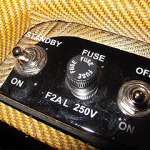Language
The Tube Amp Standby Switch Explained
If you are or have ever been the owner of a vintage-styled tube amp, you might have come across the "standby" switch, usually located near or right next to the on/off switch. While you probably already know that it comes in handy when trying to silence your amp without actually turning it off, it actually has another, more important function behind it: protecting your tubes.
With all the huge leaps in technology we have seen in even just the last few decades, its hard to believe that a technology as old as tubes is not only still around but often preferred. If you think about it, they really are pretty archaic, especially when compared to today's technology. But no matter how you slice it, you just can't beat the sound of a classic tube amp. In fact, electric guitar amplification is one of the very few areas where tube technology still thrives, and the basics of tube operation haven’t changed much. Take warming up, for example.
Just like old radios, TV sets and the room-sized ENIAC computer of 1946 (which used 17,468 vacuum tubes), tube guitar amps need a minute to warm up after you turn them on. Without getting too deep into the science, suffice it to say that tubes have to be hot in order to work properly. In fact, they have to be really hot—like, glowing hot—before you can put a strong amount of electricity through them. Naturally, it takes a brief period for them to reach their proper operating temperatures. If you turn a tube amp on and immediately crank it to full volume before the tubes have had a chance to warm up, you risk damaging your amp.
This is where the true function of the standby switch comes in; It allows the amp to be turned on but keeps the full power of the voltage from reaching its power tubes until they’ve had sufficient time to warm up. This ultimately protects the tubes and prolongs their life.
You’ll notice that the switch itself usually isn’t labeled “on/off,” but rather “on/standby.” When you first turn your amp on, you want the switch to be in the “standby” position, in which no sound will be produced while the tubes warm up. Then, anywhere from 15 seconds to a few minutes after powering up, flip the standby switch to the “on” position, and you’re ready to goat whatever volume you like.
At a rehearsal or gig, in fact, a good habit to first turn on your amp in standby mode, then go about setting up the rest of your gear—adjust pedals, run cords, tune up, order a drink, wash your hands and so forth. That usually takes at least a few minutes, after which you then flip the standby switch of your properly warmed-up amp to “on,” and off you go.

